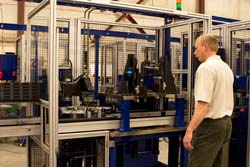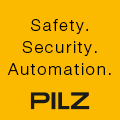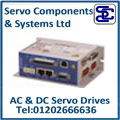
Posted to News on 1st Nov 2011, 22:23
Machine builders and the EMC Directive 2004/108/EC
Paul Laidler of Laidler Associates, part of the machinery division of TUV SUD Product Service, explains what machine builders need to know about the EMC Directive, and how they can comply in a reliable and cost-effective manner.

There can be no doubt about the need for electromagnetic compatibility (EMC). Who, for example, has not experienced a landline phone conversation that has been interrupted by chirps from a nearby mobile phone? In an ideal world, with total control of EMC, things like this would never happen. No one worries too much about the phone chirps, however, as they are just an annoyance. But when it comes to EMC and machines, the situation is very different.
If, for example, the control system of a machine is disturbed by electromagnetic interference it may randomly malfunction, creating a potentially dangerous situation. Conversely, if the electrical and electronic systems fitted to a machine generate a high level of interference, they may cause other nearby equipment to malfunction. It is to help guard against situations like these that the EMC Directive, 2004/108/EC, was put in place. In the UK, this directive is implemented by the Electromagnetic Compatibility (EMC) Regulations 2006.
To understand the implications of these regulations for machine builders, a good starting point is to look at the Guide to the Electromagnetic Compatibility (EMC) Regulations 2006, which can be downloaded free of charge from the Department for Business Innovation and Skills website at www.bis.gov.uk.
Section 2 of this guide, which covers essential requirements, includes statements that can be summarised as saying that equipment must be designed and manufactured so that the electromagnetic disturbance it creates is not excessive, and so that it has a reasonable level of immunity to electromagnetic disturbances. In addition, fixed installations must be installed applying good engineering practices and respecting the intended use of its components - and 'fixed installations' includes the majority of machines.
Conformity assessment and CE marking
Then comes a very interesting statement: "There are no conformity assessment or CE marking requirements for fixed installations." This statement is taken directly from the guide, but does it really mean that builders of machines categorised as fixed installations have no need to concern themselves with the EMC performance of their products? Indeed it does not. Note that this same section of the guide contains this statement: "the essential requirements for all equipment are set out in Regulation 4." In other words, machines that are regarded as fixed installations must still be designed and manufactured so that they meet the essential requirements; the only relaxation of the rules relates to assessment and marking, not to performance!
To be absolutely clear about these requirements, if a machine is defined as a 'fixed installation' there is no requirement to apply the CE mark in respect of EMC but it is still necessary to evaluate the EMC performance of the machine. On the other hand, if the machine is not a fixed installation, then the CE marking in respect of EMC must be applied. It is clearly important, therefore, to decide whether or not a machine is a fixed installation.
It is the opinion of Laidler Associates that the majority of machines should carry the CE marking in respect of both the Machinery Directive and the EMC Directive because they do not fall within the definition of a fixed installation. Because of this, the company always includes EMC on the Declaration of Conformity if EMC testing has been carried out.
Meeting the essential requirements
However, even if a machine is considered to be a fixed installation and CE marking in respect the EMC Directive is not needed, the essential requirements of the Directive must still be met, as we have already seen. But how can machine builders be sure that their products really do have satisfactory EMC performance? It is very tempting to think that the answer is to use only components that are themselves compliant with the EMC Regulations. Surely, if all of the components used in a machine satisfy the regulations, it is reasonable to conclude that the whole machine must also meet the regulations?
Unfortunately, that is not how it works and it is relatively easy to see why. Consider, for example, a variable-speed drive (VSD) that, for the sake of argument, produces a level of electromagnetic interference about half of that acceptable under the regulations. Clearly, there is no problem in stating that this drive complies with the regulations.
Now put four of those drives on a machine. Is it reasonable to assume that the machine complies with the regulations, simply because each of the drives is compliant? Probably not. The machine may be compliant, especially if measures to control EMC have been incorporated in its design, but the point is that it cannot be assumed to be compliant.
Verification by testing
In fact, since there is no proven way of calculating or modelling the EMC performance of a machine, it is the opinion of Laidler Associates that the only way compliance can be verified is by testing. This opinion may be considered by some as rather controversial, but when the Health and Safety Executive (HSE) was asked to comment on this issue, it provided the following statement:
"Section 6 of the Health and Safety at Work Act (HSW) places a duty on manufacturers to carry out or arrange for the carrying out of such testing and examination as may be necessary to ensure that the article is so designed and constructed that it will, as far as is reasonably practicable, be safe and without risks to health. In the context of EMC, in most applications it is the electromagnetic immunity of equipment that is of interest in relation to Section 6 of the HSW. If it is reasonably practicable to carry out testing for immunity to electromagnetic disturbances, the HSW requires this to be carried out."
This statement leaves no room for doubt about the necessity for EMC testing of machines in the vast majority of cases; there is simply no shortcut to achieving compliance with the EMC Regulations. Unfortunately, there is also no doubt that EMC testing, which can be carried out at either the machine builder's or the end user's premises, can be complex and time-consuming, especially for the majority of machine builders that lack in-house expertise in this specialist area.
Design guidance
For this reason, many machine builders find it preferable to work with a specialist consultant like Laidler Associates on matters relating to EMC. Provided that they are involved with a project at an early enough stage, a consultant of this type can provide design guidance that will help to optimise the EMC performance of the machine, as well as giving invaluable advice on compliance and testing. The consultant's services may also include arranging for and supervising the tests.
The fee charged by a consultant for providing these services is usually relatively modest, and is in almost every case far less than the money the machine builder would have spent ensuring EMC compliance without calling on expert help. In addition, working with a consultant provides the peace of mind and assurance of knowing that the compliance process has been properly completed and that nothing has been missed.
Few would deny that meeting the EMC requirements in relation to machines can be a daunting process, but ignoring those requirements is not an acceptable solution. Fortunately, help is at hand in the form of experienced EMC consultants who can provide all of the help and support machine builders need to be sure that their products always deliver impeccable EMC performance.
Follow the link for more information about Laidler Associates' EMC Directive consultancy and testing services for machine builders.
Want the latest machine building news straight to your inbox? Become a MachineBuilding member for free today >>


















